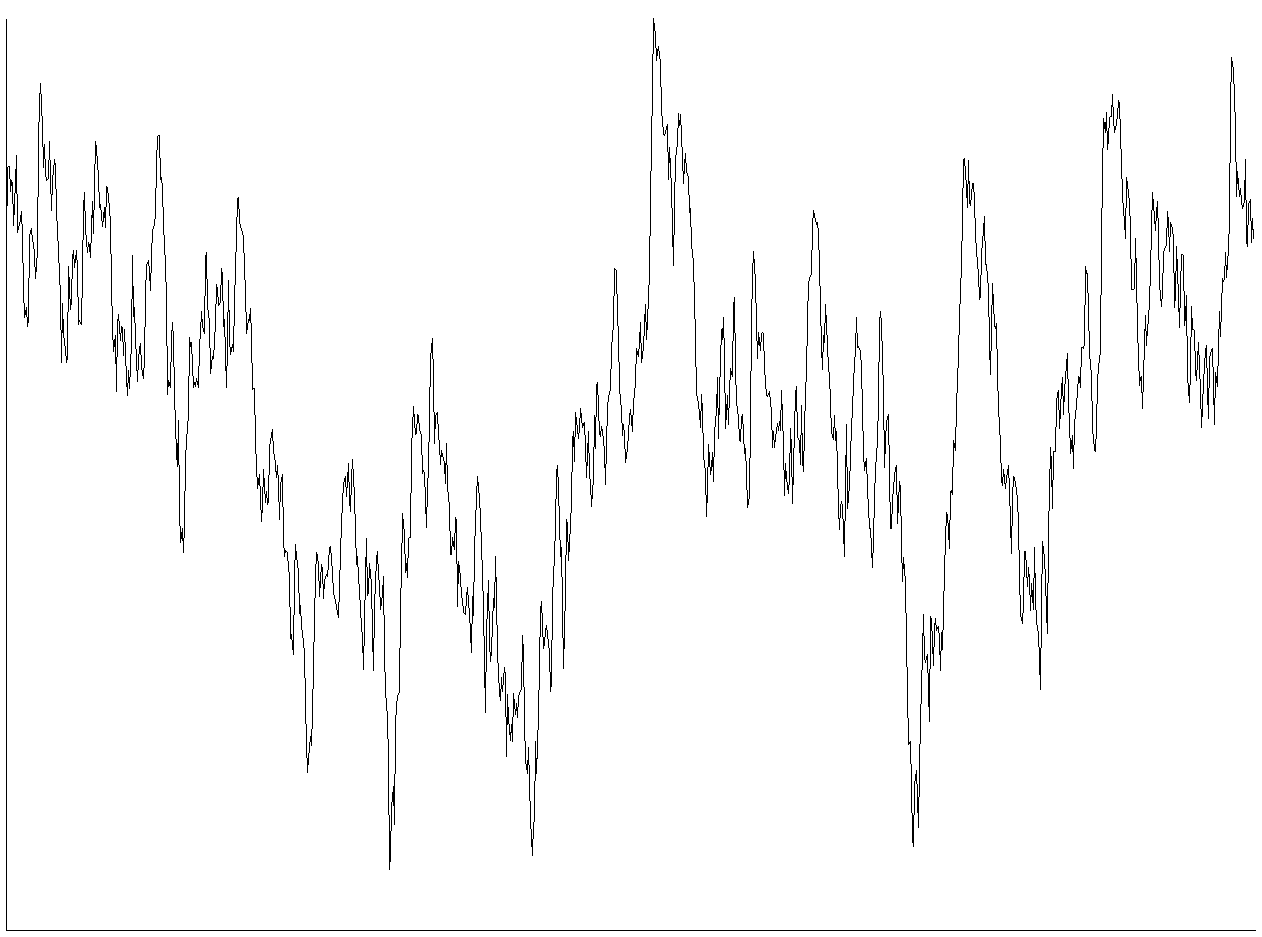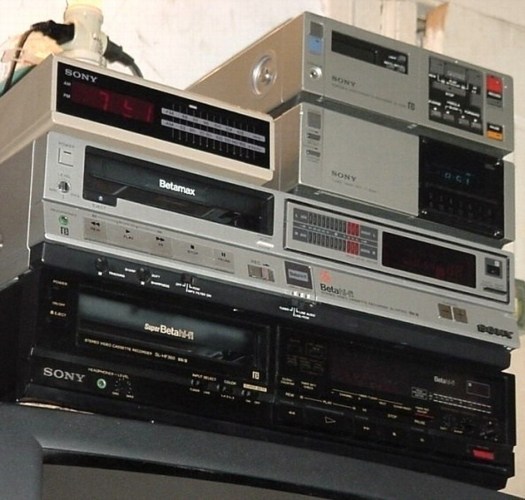|
Azimuth Recording
Azimuth recording is the use of a variation in angle between two recording heads that are recording data so close together on magnetic tape that crosstalk would otherwise likely occur. Normally, the head is perpendicular to the movement of the tape, and this is considered zero degrees. However, if the heads are mounted at slightly different angles (such as ±7 degrees in VHS), destructive interference will occur at high frequencies when reading data recorded in the cross-talking channel but not in the channel that is intended to be read. At low frequencies relative to the maximum allowed by the head gap, however, this technique is ineffective. Thus one head is slanted slightly leftwards and the magnetic gap of the other head slanted slightly rightwards. To look at it another way, channel A sees the channel B data stretched out in time, hence the technique has a low-pass effect on noise intruding from another channel. Every videotape system was designed to put as much video as pos ... [...More Info...] [...Related Items...] OR: [Wikipedia] [Google] [Baidu] |
Magnetic Tape
Magnetic tape is a medium for magnetic storage made of a thin, magnetizable coating on a long, narrow strip of plastic film. It was developed in Germany in 1928, based on the earlier magnetic wire recording from Denmark. Devices that use magnetic tape could with relative ease record and playback audio, visual, and binary computer data. Magnetic tape revolutionized sound recording and reproduction and broadcasting. It allowed radio, which had always been broadcast live, to be recorded for later or repeated airing. Since the early 1950s, magnetic tape has been used with computers to store large quantities of data and is still used for backup purposes. Magnetic tape begins to degrade after 10–20 years and therefore is not an ideal medium for long-term archival storage. Durability While good for short-term use, magnetic tape is highly prone to disintegration. Depending on the environment, this process may begin after 10–20 years. Over time, magnetic tape made in the 197 ... [...More Info...] [...Related Items...] OR: [Wikipedia] [Google] [Baidu] |
Destructive Interference
In physics, interference is a phenomenon in which two waves combine by adding their displacement together at every single point in space and time, to form a resultant wave of greater, lower, or the same amplitude. Constructive and destructive interference result from the interaction of waves that are correlated or coherent with each other, either because they come from the same source or because they have the same or nearly the same frequency. Interference effects can be observed with all types of waves, for example, light, radio, acoustic, surface water waves, gravity waves, or matter waves. Etymology The word ''interference'' is derived from the Latin words ''inter'' which means "between" and ''fere'' which means "hit or strike", and was coined by Thomas Young in 1801. Mechanisms The principle of superposition of waves states that when two or more propagating waves of the same type are incident on the same point, the resultant amplitude at that point is equal to t ... [...More Info...] [...Related Items...] OR: [Wikipedia] [Google] [Baidu] |
Low-pass
A low-pass filter is a filter that passes signals with a frequency lower than a selected cutoff frequency and attenuates signals with frequencies higher than the cutoff frequency. The exact frequency response of the filter depends on the filter design. The filter is sometimes called a high-cut filter, or treble-cut filter in audio applications. A low-pass filter is the complement of a high-pass filter. In optics, high-pass and low-pass may have different meanings, depending on whether referring to frequency or wavelength of light, since these variables are inversely related. High-pass frequency filters would act as low-pass wavelength filters, and vice versa. For this reason it is a good practice to refer to wavelength filters as ''short-pass'' and ''long-pass'' to avoid confusion, which would correspond to ''high-pass'' and ''low-pass'' frequencies. Low-pass filters exist in many different forms, including electronic circuits such as a hiss filter used in audio, anti-aliasing fil ... [...More Info...] [...Related Items...] OR: [Wikipedia] [Google] [Baidu] |
Noise (electronics)
In electronics, noise is an unwanted disturbance in an electrical signal. Noise generated by electronic devices varies greatly as it is produced by several different effects. In particular, noise is inherent in physics, and central to thermodynamics. Any conductor with electrical resistance will generate thermal noise inherently. The final elimination of thermal noise in electronics can only be achieved cryogenically, and even then quantum noise would remain inherent. Electronic noise is a common component of noise in signal processing. In communication systems, noise is an error or undesired random disturbance of a useful information signal in a communication channel. The noise is a summation of unwanted or disturbing energy from natural and sometimes man-made sources. Noise is, however, typically distinguished from interference, for example in the signal-to-noise ratio (SNR), signal-to-interference ratio (SIR) and signal-to-noise plus interference ratio (SNIR) measu ... [...More Info...] [...Related Items...] OR: [Wikipedia] [Google] [Baidu] |
U-matic
U-matic is an analogue recording videocassette format first shown by Sony in prototype in October 1969, and introduced to the market in September 1971. It was among the first video formats to contain the videotape inside a cassette, as opposed to the various reel-to-reel or open-reel formats of the time. The videotape is wide, so the format is often known as "three-quarter-inch" or simply "three-quarter", compared to open reel videotape formats in use, such as type C videotape and quadruplex videotape. Unlike most other cassette-based tape formats, the supply and take-up reels in the cassette turn in opposite directions during playback, fast-forward, and rewind: one reel would run clockwise while the other would run counter-clockwise. A locking mechanism integral to each cassette case secures the tape hubs during transportation to keep the tape wound tightly on the hubs. Once the cassette is taken off the case, the hubs are free to spin. A spring-loaded tape cover door pr ... [...More Info...] [...Related Items...] OR: [Wikipedia] [Google] [Baidu] |
Betamax
Betamax (also known as Beta, as in its logo) is a consumer-level analog recording and cassette format of magnetic tape for video, commonly known as a video cassette recorder. It was developed by Sony and was released in Japan on May 10, 1975, followed by the US in November of the same year. Betamax is widely considered to be obsolete, having lost the videotape format war which saw its closest rival, VHS, dominate most markets. Despite this, Betamax recorders continued to be manufactured and sold until August 2002, when Sony announced that they were discontinuing production of all remaining Betamax models. Sony continued to sell Betamax cassettes until March 2016. Original version Launch and early models The first Betamax device introduced in the United States was the LV-1901 console, which included a color monitor, and appeared in stores in early November 1975. The cassettes contain videotape in a design similar to that of the earlier, professional , U-matic format. L ... [...More Info...] [...Related Items...] OR: [Wikipedia] [Google] [Baidu] |
Symmetric Phase Recording
Symmetric Phase Recording is a tape recording (Computer storage media) technology developed by Quantum Corporation packs data across a tape's recording surface by writing adjacent tracks in a herringbone pattern: track 0 = \\\\\, track 1 = /////, track 2 = \\\\\, track 3 = /////, etc. This eliminates crosstrack interference and guard bands so that more tracks of data can be stored on a tape. References Further reading * * See also *Azimuth recording, Slant Azimuth recording *Digital Equipment Corporation *Digital Linear Tape *Linear Tape-Open *Digital Tape Format *Helical scan *Magnetic tape *Magnetic tape data storage Magnetic-tape data storage is a system for storing digital information on magnetic tape using digital recording. Tape was an important medium for primary data storage in early computers, typically using large open reels of IBM 7 track, 7-track, ... * Storage Technology Corporation Storage media {{Compu-hardware-stub ... [...More Info...] [...Related Items...] OR: [Wikipedia] [Google] [Baidu] |
Tape Head
A tape head is a type of transducer used in tape recorders to convert electrical signals to magnetic fluctuations and vice versa. They can also be used to read credit/debit/gift cards because the strip of magnetic tape on the back of a credit card stores data the same way that other magnetic tapes do. Cassettes, reel-to-reel tapes, 8-tracks, VHS tapes, and even floppy disks and early hard drive disks all use the same principle of physics to store and read back information. The medium is magnetized in a pattern. It then moves at a constant speed over an electromagnet. Since the moving tape is carrying a changing magnetic field with it, it induces a varying voltage across the head. That voltage can then be amplified and connected to speakers in the case of audio, or measured and sorted into ones and zeroes in the case of digital data. Principles of operation The electromagnetic arrangement of a tape head is generally similar for all types, though the physical design varie ... [...More Info...] [...Related Items...] OR: [Wikipedia] [Google] [Baidu] |
Helical Scan
Helical scan is a method of recording high-frequency signals on magnetic tape. It is used in open-reel video tape recorders, video cassette recorders, digital audio tape recorders, and some computer tape drives. History Earl E Masterson from RCA patented the first helical scan method in 1950 after stealing it from German engineer Eduard Schüller. Eduard Schüller developed an actually working helical scan method of recording in 1953 while working at AEG. With the advent of television broadcasting in Japan in the early 1950s, they saw the need for magnetic television signal recording. Dr. Kenichi Sawazaki developed a prototype helical scan recorder in 1954. Gallery Bcn-scanner-head.jpg, Type B videotape video scanner head Vxa1-drive-nocover-nobezel-front.jpg, rotary head visible in a VXA computer tape drive Vxa1-drive-nocover-top-front.jpg, VXA tape drive, alternate view of rotary head and loading mechanism See also * Type A videotape * 1 inch type B videotape * 1 i ... [...More Info...] [...Related Items...] OR: [Wikipedia] [Google] [Baidu] |
Helical Scan
Helical scan is a method of recording high-frequency signals on magnetic tape. It is used in open-reel video tape recorders, video cassette recorders, digital audio tape recorders, and some computer tape drives. History Earl E Masterson from RCA patented the first helical scan method in 1950 after stealing it from German engineer Eduard Schüller. Eduard Schüller developed an actually working helical scan method of recording in 1953 while working at AEG. With the advent of television broadcasting in Japan in the early 1950s, they saw the need for magnetic television signal recording. Dr. Kenichi Sawazaki developed a prototype helical scan recorder in 1954. Gallery Bcn-scanner-head.jpg, Type B videotape video scanner head Vxa1-drive-nocover-nobezel-front.jpg, rotary head visible in a VXA computer tape drive Vxa1-drive-nocover-top-front.jpg, VXA tape drive, alternate view of rotary head and loading mechanism See also * Type A videotape * 1 inch type B videotape * 1 i ... [...More Info...] [...Related Items...] OR: [Wikipedia] [Google] [Baidu] |


.jpg)



